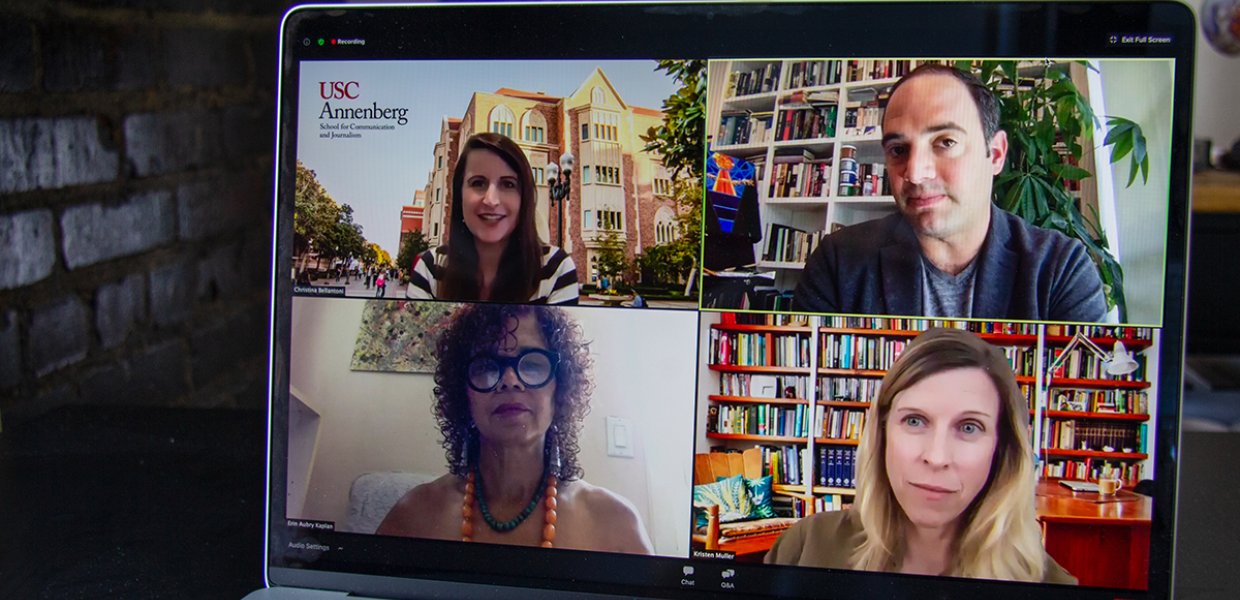At the first #FutureOfLocalNews event on Aug. 4, the discussion was often about what the future should not look like.
“It's not just about broadcasting … or writing about the headlines,” said Kristen Muller, chief content officer of KPCC, Southern California Public Radio. “It's really about serving as kind of — almost a help desk. And part of that help is making sure people feel reflected and represented in those stories. … That’s an imperative that many organizations haven't always had in the past.”
The new panel discussion series, presented by USC Annenberg and KPCC, Southern California Public Radio and held virtually via Zoom webinar, brings leading scholars and journalists together to explore how to create a sustainable and inclusive future for local news in Southern California.
With more than two hundred guests in virtual attendance, Muller moderated the discussion among panelists Christina Bellantoni, director of USC Annenberg’s Media Center; León Krauze, the lead anchor for KMEX-TV, Univision’s Los Angeles station, and columnist for many publications, including Slate and the Washington Post; and Erin Aubry Kaplan, author and columnist for The New York Times.
In addition to weighing in how journalism has been affected by the COVID-19 pandemic and the Black Lives Matter movement, as well as taking questions from attendees, the panelists also shared ideas about how news organizations in Los Angeles and beyond can position themselves for success in the face of an uncertain future.
Here, in their own words, are a few key takeaways from the panelists on the topics Muller raised during the event.
On building new funding models for professional journalism
Christina Bellantoni
“It feels like there's got to be a reckoning. Whether it's getting people to understand the value of paying for their news … or some sort of model that allows people to be more invested in their local communities. Or maybe it's the nonprofit model, which is starting to grow, like CALMatters and The Center for Investigative Reporting.”
“I like to talk a lot about Report for America, which is an organization Annenberg supports, and that I have been involved in as a judge. They have a really interesting model. It's like the Peace Corps: Newsrooms apply with a need of something that they want cover, and … [reporters] are required to work in their community. … And that’s a really great way to build great journalism.”
“We can maybe even have smart membership models, where people pay just a little bit, the same way that I donate to KPCC every month, because it's so important to me. I think that provides a lot of hope — and it is possible.”
On moving beyond outdated ideas of how media outlets should cover their communities
Erin Aubry Kaplan
“Journalism remains important and it has to be done — and people aren't going to do it for free. And we all need to be paid equally. This is one of the many clashes we're having right now between social justice, public service and capitalism.”
“We have to understand the difference between … being ‘neutral,’ and understanding, what is the nature of what we're reporting on? Like gentrification, which impacts Black people in a different way than it impacts Latino people. There's a commonality, but there are differences. And we need to parse those differences, to not be afraid to look at those issues and understand that those issues affect everybody … and that the people-of-color lens is valid for all of us in the same way the white lens is valid.”
On the responsibility to report across racial and ethnic lines
León Krauze
“I think that Spanish-language media sometimes fails to acknowledge news that is not related to the [Spanish-speaking] community. … I think that's a mistake. When we do otherwise, the result has been very touching. The best example is the way we covered Nipsey Hussle’s murder. We went into the African American community, we told the story, and the response was phenomenal. The value of expanding the lens of coverage really proved to be really touching and really valuable.”
"We, as journalists ... really should be the masters of reinvention. … In the end, it goes back to creativity, both on the editorial side of things and the business side of things.”
